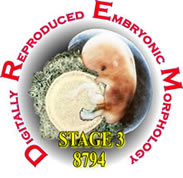

| #8663 Opening Screen | Embryo 8794 Figures | Download Section Images |
| Browse Sections | Stage 3 Opening Screen | Help / Instructions |
| 3D Models | Stage 3 Introduction | Credits |
Stage 3 specimens have a postfertilization age of between four and five days in vivo. Embryo #8794 is one of two stage 3 embryos in the Carnegie collection. It is a 58-cell blastocyst estimated to be about 96 hours old. Lack of precise data on the time of ovulation means that the postfertilization age of the embryo could be between 72 and 108 hours.
Before fixation the specimen measured 230 x 190 µm including the zona pellucidaand the blastocyst was almost spherical with a diameter of 150 µm. After fixation the overall size of the embryo was 108 x 86 µm. ( Table of Dimensions; Hertig et al., 1954)
The specimen was collected and prepared for microscopic examination in 1950. It was fixed in 70% alcohol and Bouin’s fluid, embedded in celloidin paraffin, and serially sectioned at 6 µm. [ Note that although the section thickness is recorded as 6 µm by O'Rahilly & Müller (1987) the data provided by Hertig et al. (1954) and our 3D-reconstructions suggest that the section thickness was closer to 9 microns.] The sections were mounted on a glass slide and stained with H & E. Eleven serial sections through the embryo were obtained, 10 of them are included in the database. Structures are identified on every section image. The morphology of this embryo is well documented in the literature. It was first described by Hertig et al. in 1954.
The sections have been digitally restored and labeled, and can be viewed at two magnifications. Several 3D reconstructions have been generated from the aligned sections. Animations of these 3D-reconstructions are included on the disks.
Instructions for using the disks can be found by going to the Instructions section from the opening screen.